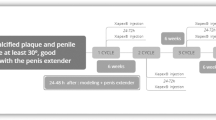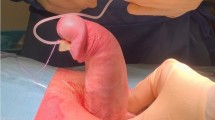Abstract
Peyronie’s disease (PD) can be managed with surgery or intralesional injections of Collagenase clostridium histolyticum (CCH) however both are associated with side effects and variable results. It is unclear how many patients elect to undergo additional surgical correction after CCH. To answer this, we analyzed the Department of Veterans Affairs Informatics and Computing Infrastructure (VINCI) software. We performed a retrospective analysis over a 5-year period for patients with PD, at least one injection of CCH and surgical CPT codes. In total, 17,646 patients with PD were analyzed with 1541 treated with CCH. Only 51 (3.3%) were treated with secondary surgical intervention after CCH. Three main surgical procedures were performed: penile plication (51%), penile prosthesis (29%) and plaque excision and grafting (20%). Of the 51 men who underwent surgical corrections post CCH, the most common reason was lack of response/residual curvature (62.8%), followed by ED (29.4%). Previous literature shows that CCH was effective for only 60.8% of patients, potentially leaving the remaining in need of additional treatment. Despite this we found that only 3.3% received secondary therapy in the VA medical system, with residual curvature being the most common reason.
This is a preview of subscription content, access via your institution
Access options
Subscribe to this journal
Receive 8 print issues and online access
$259.00 per year
only $32.38 per issue
Buy this article
- Purchase on Springer Link
- Instant access to full article PDF
Prices may be subject to local taxes which are calculated during checkout
Similar content being viewed by others
References
Bjekic MD, Vlajinac HD, Sipetic SB, Marinkovic JM. Risk factors for Peyronie’s disease: a case-control study. BJU Int. 2006;97:570–4.
Gelbard M. Myofibroblasts and mechanotransduction: do forces in the tunica albuginea contribute to Peyronie’s disease? J Sex Med. 2008;5:2974–6.
Terrier JE, Nelson CJ. Psychological aspects of Peyronie’s disease. Transl Androl Urol. 2016;5:290–5.
Nehra A, Alterowitz R, Culkin DJ, Faraday MM, Hakim LS, Heidelbaugh JJ, et al. Peyronie’s disease: AUA guideline. J Urol. 2015;194:745–53.
Jordan GH. The use of intralesional clostridial collagenase injection therapy for Peyronie’s disease: a prospective, single-center, non-placebo-controlled study. J Sex Med. 2008;5:180–7.
Gelbard M, Goldstein I, Hellstrom WJ, McMahon CG, Smith T, Tursi J, et al. Clinical efficacy, safety and tolerability of collagenase clostridium histolyticum for the treatment of peyronie disease in 2 large double-blind, randomized, placebo controlled phase 3 studies. J Urol. 2013;190:199–207.
Cocci A, Russo GI, Briganti A, Salonia A, Cacciamani G, Capece M, et al. Predictors of treatment success after collagenase Clostridium histolyticum injection for Peyronie’s disease: development of a nomogram from a multicentre single-arm, non-placebo controlled clinical study. BJU Int. 2018;122:680–7.
Wymer K, Ziegelmann M, Savage J, Kohler T, Trost L. Plaque Calcification: an important predictor of collagenase clostridium histolyticum treatment outcomes for men with Peyronie’s disease. Urology 2018;119:109–14.
Hellstrom WJG, Tue Nguyen HM, Alzweri L, Chung A, Virasoro R, Tapscott A, et al. Intralesional collagenase clostridium histolyticum causes meaningful improvement in men with Peyronie’s disease: results of a multi-institutional analysis. J Urol. 2019;201:777–82.
Affairs USDoV. VA Informatics and Computing Infrastructure (VINCI): Office of research & development. Available from: https://www.research.va.gov/programs/vinci/default.cfm.
Levine LA, Larsen SM. Surgical correction of persistent Peyronie’s disease following collagenase clostridium histolyticum treatment. J Sex Med. 2015;12:259–64.
DeLay K, Diao L, Nguyen HMT, Zurawin J, Libby R, Yafi F, et al. Successful treatment of residual curvature in peyronie disease in men previously treated with intralesional collagenase clostridium histolyticum. Urology 2017;110:110–3.
Ziegelmann MJ, Viers BR, McAlvany KL, Bailey GC, Savage JB, Trost LW. Restoration of penile function and patient satisfaction with intralesional collagenase clostridium histolyticum injection for Peyronieʼs disease. J Urol. 2016;195:1051–6.
Bajic P, Wiggins AB, Ziegelmann MJ, Levine LA. Characteristics of men with peyronie’s disease and collagenase clostridium histolyticum treatment failure: predictors of surgical intervention and outcomes. J Sex Med. 2020;17:1005–11.
Nguyen HMT, Anaissie J, DeLay KJ, Yafi FA, Sikka SC, Hellstrom WJG. Safety and efficacy of collagenase clostridium histolyticum in the treatment of acute-phase Peyronie’s disease. J Sex Med. 2017;14:1220–5.
Author information
Authors and Affiliations
Contributions
IZ was responsible for project conception/design; literature review; manuscript drafting/revisions. SN was responsible for project conception/design; literature review; statistical analysis; manuscript drafting/revisions; tabulation of data. TM was responsible for project conception/design; manuscript drafting/revisions.
Corresponding author
Ethics declarations
Competing interests
The authors declare no competing interests.
Additional information
Publisher’s note Springer Nature remains neutral with regard to jurisdictional claims in published maps and institutional affiliations.
Supplementary information
Rights and permissions
About this article
Cite this article
Zucker, I.J., Nackeeran, S. & Masterson, T.A. The incidence of surgical intervention in veterans treated with Collagenase clostridium histolyticum. Int J Impot Res 36, 223–225 (2024). https://doi.org/10.1038/s41443-022-00658-1
Received:
Revised:
Accepted:
Published:
Issue Date:
DOI: https://doi.org/10.1038/s41443-022-00658-1



